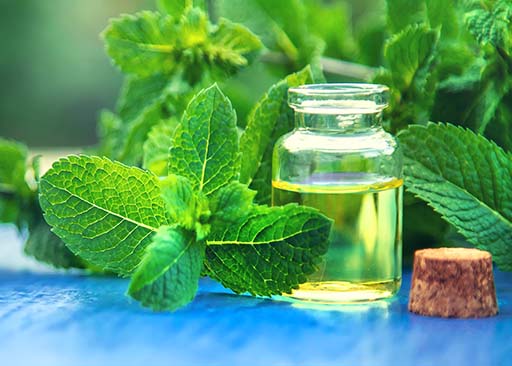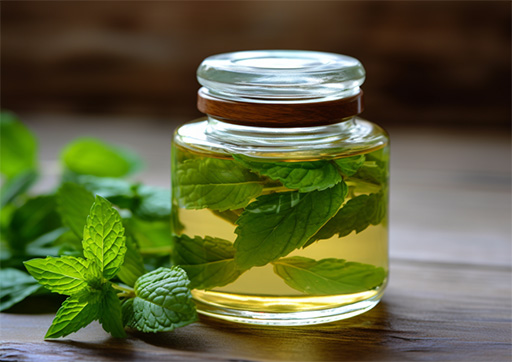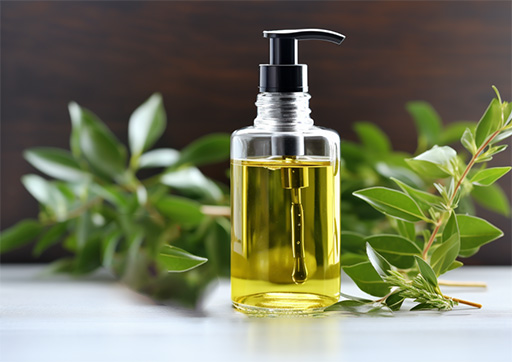How To Make Peppermint Oil [Infused And Essential]

The refreshing minty smell of peppermint oil is touted for its therapeutic properties. It was used as a natural remedy for centuries known to help alleviate muscle pain, improve digestion, respiratory function, and support cognitive health. Let’s not forget the relaxing and uplifting effects of the scent, either!
With the use of BioScan testing, you can precisely track patient reactions and progress when using peppermint oil. This revolutionary device provides insights that takes the guesswork out of essential oil use. Equipped with this knowledge, you can create targeted plans to truly maximize the benefits of peppermint oil.
Benefits Of Peppermint Oil
Studies suggest that peppermint oil has antimicrobial, antiviral, and anti-inflammatory properties. Peppermint oil contains menthol, a compound that has analgesic and cooling benefits. Menthol is the main component of peppermint oil that gives it its refreshing scent and therapeutic properties.
Apart from menthol, peppermint oil also contains carvacrol and limonene. Carvacrol is a compound with antimicrobial properties, while limonene is a compound with non-inflammatory and antioxidant properties. These compounds work together to provide various therapeutic benefits for the body.
Two Types Of Peppermint Oil Recipes
There are two types of peppermint oil recipes: infused and essential. Both have therapeutic properties, but they are made differently and have different uses.
Infused peppermint oil is made by steeping fresh or dried mint leaves in a carrier oil like olive, grapeseed, or sunflower oil. The longer they steep, the more potent the final product will be. They are often used in skincare products like lip balms and lotions or refreshing room spray.
Essential peppermint oil is made by extracting the essential oils from the mint leaves. This is done through distillation, which separates the oil and water-based compounds in the plant. The result is a clear, colorless (sometimes yellow) oil with a potent minty smell. This type of peppermint oil is more concentrated and has a higher menthol content than infused oil. It is often used in aromatherapy, massage therapy, and other therapeutic applications.
Although both types of essential oils have therapeutic properties, essential oils are generally considered more potent. They should be used with caution and only in diluted form.
Now that we’ve nailed down the basics, here are some things to consider on how to make peppermint oil.
How To Make Peppermint Oil (Infused)
Infused peppermint oil is a great way to enjoy the therapeutic properties of mint oil at home. It’s an easy recipe to make and only requires a few simple ingredients.
Here’s what you’ll need:
1) Fresh or dried peppermint leaves (preferably organic) – You’ll want to ensure that you get high-quality, organic peppermint leaves for the best results.
2) Carrier oil of your choice (olive, grapeseed, sunflower, etc.) – The type of carrier oil you use will affect the final potency and flavor of the infused oil. Carrier oils come in many different varieties, so you can choose the one that best suits your needs.
Grapeseed oil has a light, neutral taste and is high in antioxidants. It’s also beneficial for skin health. Olive oil is a classic choice for carrier oils and has a strong, earthy flavor. It’s high in monounsaturated fatty acids, good for the heart. Sunflower oil is another good option and is high in Vitamin E. It has a mild, nutty flavor and is suitable to apply for all skin types.
3) Glass jar with a tight-fitting lid – A tight-fitting lid ensures that light and air won’t escape from the infusion, and the oil won’t degrade over time. Amber jars are ideal for storing oils, as they protect the oil from light damage.


(Infused) Instructions:
1) Fill a jar with fresh or dried peppermint leaves – If you’re using fresh leaves, you’ll need to chop them up into small pieces before adding them to the jar. You may also need twice as many leaves, as wet leaves contain more water than dried ones. Ensure that they are dry before adding them, or they will rot and contaminate the oil.
If you’re using dried leaves, crumble them into small pieces before adding them to the jar. Alternatively, you may also use a mix of both leaves. The more peppermint leaves you use, the stronger the final product will be.
2) Pour carrier oil over the leaves – You’ll need enough oil to submerge them thoroughly. If you’re using a solid carrier oil, like coconut oil, you’ll need to melt it before adding it. Make sure that the oil temperature is below 100 degrees Fahrenheit before adding it to the jar, or you’ll risk damaging the essential oils in the leaves. Don’t fill up the whole jar, otherwise the extract will be too diluted.
They will need to steep for at least two weeks, but the longer they soak, the more potent the oil. Ideally, you’ll want to let them steep for four to six weeks for best results.
3) Store the infused peppermint oil – Once the oil has finished steeping, strain it through a strainer and pour it into a clean glass bottle. Store it in a cool, dark place and use it as needed or desired. The oil will keep for up to one year.

How To Make Peppermint Essential Oil
Making peppermint essential oil is more complicated but worth the effort. The product is a high-quality essential oil with a potent mint flavor and aroma. The overall process requires more complex steps and may take a few weeks.
Here’s what you’ll need:
1) Fresh peppermint leaves – Commercial-grade essential oils are often made from plants that have been harvested many months ago and then distilled. The resulting oil may not have the same potency or flavor as an essential oil made from undried herbs. So, it’s best to grow your own peppermint if you want to make high-quality homemade essential oil.
If you don’t live in an area where peppermint grows wild, you can purchase the herb from a health food store. Just get organic leaves since conventional peppermint plants may not be free of pesticides or other chemicals.
It is best to use the leaves from the top of the plant since they contain the most essential oil. Harvesting from the bottom of the plant will yield a lower quality oil.
2) Glass jar or container – You’ll need a jar or another bottle container to hold the oil. Mason jars work well, but any sturdy jar will do. Be sure to leave enough room at the top for the leaves to expand as they soak in the oil. Plastic containers aren’t recommended since they may leach chemicals into the oil.
3) Pot or double boiler – You’ll need a pot or double boiler to heat the oil and extract the essential oils from the leaves. A pot with a thick bottom is preferable since it will distribute heat more evenly. If you don’t have a double boiler, you can place the jar inside a saucepan filled with water. Just be sure to keep the water level below the top of it.
Is it possible to make peppermint oil without using heat?
Yes, it is possible to make peppermint oil without heat. One method is the cold infusion method, where the peppermint leaves are soaked in carrier oil for a few weeks to extract the oils naturally. This process requires a lot of patience but results in a high-quality, heat-free peppermint oil.
(Essential) Instructions:
Larger companies that distill essential oils in bulk use a process known as steam distillation. The plant material is placed in a large container and hot water is added in this process. The resulting steam is then captured and cooled, causing the essential oils to condense and fall back into the container. The cooled essential oil is then collected and bottled. In this process, the steam also condenses into hydrosol, a byproduct that is often used in aromatherapy and skincare products.
Small-scale distillation can also be done using a pot or double boiler. Place the peppermint leaves in the pot and add enough water to cover them. It will ensure that the essential oils draw out the leaves and water.
Bring the water to a gentle simmer and let it cook for about 30 minutes. Please check on it frequently since you don’t want the water to boil away entirely.
Collect the steam by placing a jar inside the pot. The steam will condense and fall back in, where it will be collected. Let the mixture cool for a few minutes, and then strain out the leaves using a strainer.
The resulting oil should be clear or slightly yellow. If it’s cloudy, you’ll need to distill it again. Pour the oil into a bottle or storage container and label it with the date. Store it in a cool, dark place.
Alternatively, you can purchase small distillation units online. These are relatively smaller than the ones used by larger essential oil companies and can be used to produce high-quality essential oils in small batches. When choosing a distillation unit, be sure to get one made for essential oils.
Safety Tips and Precautions for Mint Oil Extract

It is also worth noting that peppermint oil is potent and should always be used cautiously. When working on your peppermint oil recipe, whether infused or essential, remember to wear protective gloves and goggles. It is imperative if you’re working with essential oils in the distillation process.
Remember that essential oils are potent and may cause irritation when applied topically. After learning how to make peppermint oil, always dilute essential oils with a carrier oil before you apply them on the skin. Perform a patch test before using them on a large area.
Also, avoid contact with the oil by avoiding contact with your eyes. If any of the oil does meet your skin, be sure to wash it off immediately with a carrier oil – and not with water. Water will only spread the oil and make it harder to remove. On the other hand, carrier oil will help dissolve the oil and make it easier to wash off.
Incorporate Peppermint Oil Into Patient Health
Homemade peppermint oil is excellent for those looking for an additional modality outside of traditional medicine. And with peppermint oil, you have a versatile oil used with many chronic medical conditions. Some of the peppermint benefits include:
Aromatherapy: Peppermint oil is excellent for aromatherapy. It can help improve concentration, relieve stress and anxiety, and even provide relief from pain. When using it in aromatherapy, add a few drops of oil to a diffuser and let it diffuse into the air.
Topical Application: Peppermint oil can be applied topically to relieve pain, muscle aches, and headaches. It can also be used as a cooling agent for sunburns or other skin irritations. When applying peppermint oil topically, dilute it with a carrier oil first.
Internal Use: Peppermint oil can also be taken internally for digestive issues like nausea, indigestion, and constipation. It can also be used as a breath freshener or to help relieve symptoms of colds and flu.
BioScan and Peppermint Oil
You can use tools like the BioScan to revolutionize how you understand and improve patient health.. The BioScan is a device that uses Galvanic Skin Response (GSR) to collect data about your patient’s body. It is a non-invasive device that is safe for both adults and children. Today, practices now utilize these tools not just for assessment but also to follow the effectiveness of an oil-based protocol over time.
